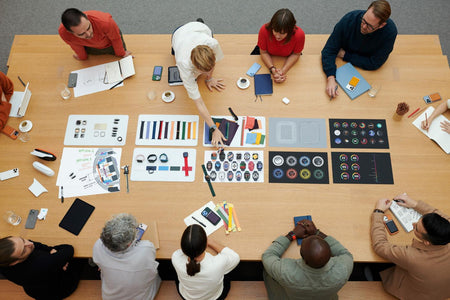Introduction
Apple Industrial Design was established in April 1977 when Steve Jobs hired Jerry Manock to design the Apple II housing. The group was established so that Apple could design more products in-house, rather than relying on external design firms to ensure that changes to be made more efficiently - all while making it easier to maintain the secrecy of upcoming projects. The importance that Jobs put on appearance led to a desire to begin the search for a "world-class" designer/design team to give Apple a unique and uniform design language to their products.
Apple’s elite Industrial Design Group are only made up of a small group of employees but have been credited in the rapid growth of making Apple the largest electronics consumer brand and the world’s most valuable company.

The 1980s
Following the first 10 years Jobs and Manock set about establishing the design language that would be used by Apple, simplicity thus became Apple’s core design value and became the foundation of Apple’s design history.
Apple officials looked outside the company for a designer who could help them establish the firm as a world-class company in which they hired Hartmut Esslinger who worked on Snow White which was the new design language was to be applied to the Apple IIc computer. Esslinger favoured a bright-white colour originally but Manock successfully argued that it would attract fingerprints.
The two young designers Manock and Terry Oyama worked alongside Jobs to create the first Mackintosh. Guidance from Jobs resulted in many iterations of the design until, Manock and Oyama finally created a sleek and narrow computer, in-line with Jobs’ insistence on making the machine look friendly; favouring a beige-like colour scheme.

The 1990s
With the move away from Hartmut Esslinger’s design, Apple chose to bring all industrial design in-house by creating the Apple Industrial Design Group, headed by Robert Brunner.
Back from his return in the late 80s, Jobs partnered up with Jonathan Ive, Apple’s previous Chief Design Officer. For both Ive and Jobs, design was not just about how a product looked on the surface but also reflected the product’s essence. And their first true success came with the iMac, which Jobs has defined as an all-in-one product, with keyboard and monitor and computer combined in one simple unit that was ready to use right out of the box.
Steve and Ive entirely redesigned the Mac monitor and pioneered the design language that defines everything Apple does today. Be it their unique products, the operating systems or apps that run on these devices, or the simplicity of how they communicate as an ecosystem, Apple’s focus on the more minor aspects of technology gives it a competitive advantage.
The 2000s
Ive and his group of industrial designers including Apple designer Christopher Stringer were the principal inventors at Apple. Stringer defines the role of an industrial designer at Apple as one “to imagine objects that don’t exist and to guide the process that brings them to life. And so that includes defining the experience that a customer has when they touch and feel our products.”



But Apple’s true revolution came with the iPhone, which took the simplicity of the iPod to a whole new level. As Andy Grignon, senior manager at Apple iPhone division, told, “Apple had just acquired a company called FingerWorks, which made multi-touch keyboards. So the idea was born to do a full touch-screen-based platform for the phone. Ive has overseen the design of Apple's popular i-devices, including the iMac, iPhone and iPad.
Some of the Apple design team are known but we see names such as Shin Nishibori, Richard Howarth, Julian Hoenig, Rico Zorkendorfer and Miklu Silvanto who pioneered the exponential growth the Apple’s designs in the first iPhone prototypes, Apple Watch and so on to create a insatiable desire surrounding Apple as a brand.

The 2019 and the future
Many of the 2000s Apple’s design team had moved on to bring a new wave of ideas and innovation to Apple. Today, the Apple Design Team is led by Evans Hankey (VP of industrial design) alongside Alan Dye (VP human interface design) who hold an enormous sway over our ever-evolving relationship with technology and how this translates to user interaction paved by Ive’s previous design team.

We see Apple continue to revolutionise technology today and even though there may be some design changes that are unconventional to previous years, we believe that the new team will continue to uphold the values in Apple products to consumers and the tech industry.
What are your thoughts on how Apple’s design team have progressed these recent years? Chat to us on Twitter or Instagram!



